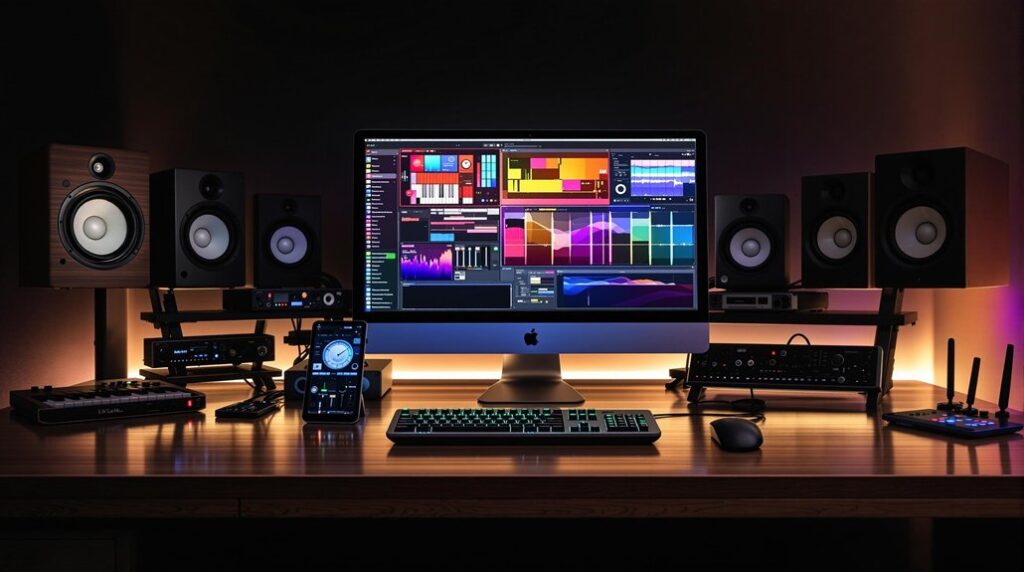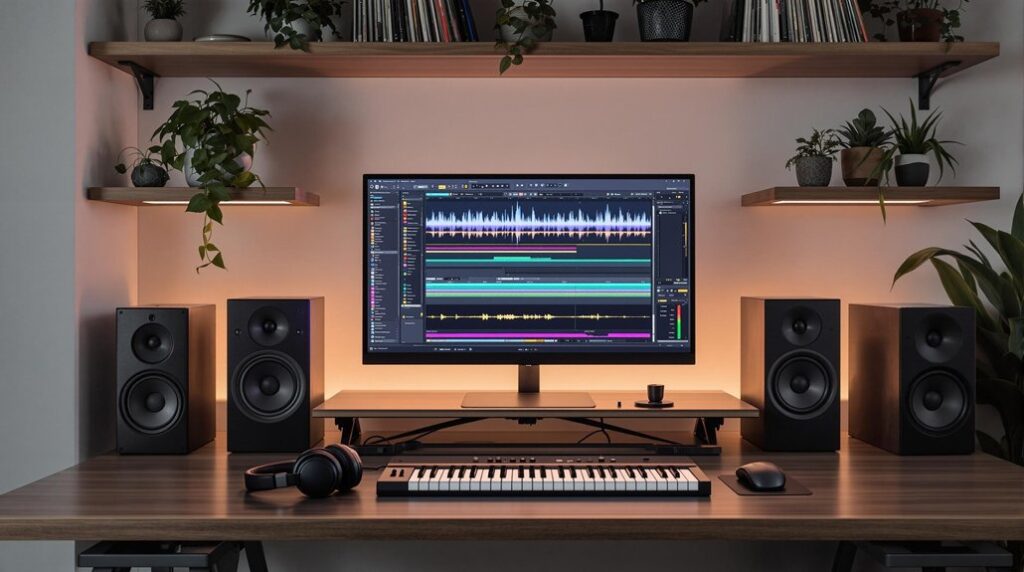To update Ableton efficiently, follow these five essential steps. First, verify system requirements and confirm an active update plan. Second, back up all projects and samples to prevent data loss. Next, download and install the update by logging into your Ableton account and following the installation prompts. Then, authorize the software by directing to the Help menu within Ableton Live, confirming a stable internet connection. Finally, explore the new features and enhancements available to enhance your music production experience. For further insights into maximizing your update benefits, additional details are readily accessible.
Key Takeaways
- Verify your system requirements and ensure your macOS is compatible with the latest Ableton Live version.
- Backup all essential project files and samples to secure locations before initiating the update.
- Log into your Ableton account to download the latest installer and follow the installation steps.
- Authorize the update by signing in to your Ableton account within the software after installation.
- Explore new features post-update and consider enabling automatic updates for future versions.
Key Preparations for Updating
Before initiating the update process for Ableton Live, it is critical to confirm that your system aligns with the requirements of the new version.
Begin by verifying system requirements on the official website to ascertain macOS compatibility. Confirm that you possess an active update plan and a registered copy of the current version of Ableton Live, allowing you to download the latest version.
Prior to proceeding, backup existing projects, samples, and files meticulously to mitigate the risk of data loss. Additionally, organize your projects and files in a structured manner, facilitating seamless access post-update.
These preparatory steps will enhance the efficiency and security of your update process, guaranteeing a smooth shift to the latest features and improvements. Moreover, ensure that your laptop meets the recommended specifications for music production performance, which can significantly impact your experience with Ableton Live.
Backing Up Your Files
With the preparatory steps completed, ensuring the security of your work is paramount. To prevent data loss during the Ableton update, back up essential project files, sample libraries, and custom settings.
Copy these to secure locations, such as external drives or cloud storage, and establish a routine for regular backups. This practice is vital, particularly before significant updates or changes to your system.
Additionally, create a complete system restore point or disk image to provide a fallback option should any issues arise during the update installation.
It is advisable to save project files in multiple secure locations and utilize version control by saving different iterations, allowing you to revert to earlier versions if necessary after the update. Also, consider using budget-friendly mastering software, such as iZotope Ozone 10 Elements, which can help optimize your audio projects post-update.
Downloading and Installing
To begin the process of updating Ableton Live, navigate to the Ableton website and log into your account. Once logged in, access the download link specific to your operating system. For successful installation, guarantee a stable internet connection and close unnecessary applications to avoid conflicts. Additionally, ensure you are aware of the default installation locations for any plugins you may want to integrate after the update.
| Step | Windows |
|---|---|
| Download | Access the installer from the website. |
| Run Installer | Execute the downloaded file. |
| Follow Instructions | Select destination folder. |
| Activate Software | Use your Ableton account credentials. |
| macOS Specific | Download the Universal build and run. |
For macOS users, allow necessary changes in security settings and choose to replace or install separately. Complete the installation process to enjoy the latest features.
Authorizing the Update
After completing the installation of the latest version of Ableton Live, the next step involves authorizing the update to guarantee your software functions correctly.
Begin by ensuring you have an active internet connection, as this is vital for the authorization process. Open Ableton Live and navigate to the Help menu, then select “Authorize at Ableton.com.”
You will be prompted to log in using your Ableton account credentials. If required, enter your product serial number to proceed.
Follow any on-screen instructions carefully to successfully validate your updated software. Completing this authorization process is essential to access all features and updates available in the new version of Live, ensuring best performance and functionality.
Exploring New Features
Ableton Live 11 introduces a range of innovative features that greatly enhance the user experience and creative potential. Users can expect:
- Comping: Compile the best performances from multiple takes, streamlining the editing process.
- MIDI Polyphonic Expression (MPE): Offers advanced control for expressive MIDI compositions.
- Hybrid Reverb: Combines physical space characteristics with algorithmic flexibility for unique sound design.
To fully benefit from these enhancements, make sure automatic updates are enabled to download and install the new version seamlessly. Additionally, understanding how to maintain mix integrity will help you get the most out of these new features.
For further assistance, refer to the Ableton Knowledge base and utilize Learn Live for in-depth help and learning.
Should you encounter issues, consult the Troubleshooting Automatic guide to resolve any concerns efficiently.
Frequently Asked Questions
How Do I Update Ableton to the Latest Version?
To update Ableton, guarantee software compatibility, download the latest version from your account, and follow the installation process. This provides performance enhancements, new Ableton features, and addresses any potential troubleshooting issues related to version history.
How Do You Upgrade Ableton?
To upgrade Ableton, guarantee software compatibility with your system. Download the latest version, noting version differences. Follow installation tips for ideal performance enhancements and bug fixes, while considering user interface updates during the upgrade process.
Does Ableton Update Automatically?
Yes, Ableton can update automatically if enabled in user preferences. However, this depends on software compatibility, system requirements, and version history. Users with earlier versions or specific plugins may need to perform manual updates.
How to Check if Ableton Is up to Date?
To check if Ableton is up to date, navigate to the Help menu, select “Check for Updates,” and review release notes. Additionally, compare versions against the user community feedback and system requirements checklist for peak performance.
Conclusion
In summary, updating Ableton is a straightforward process that enhances functionality and introduces new features. Key preparations, including backing up files, guarantee data security during the update. The downloading and installation procedures are streamlined, followed by the authorization of the update. Finally, exploring the newly introduced features allows for a more efficient and enriched user experience. Adhering to these steps guarantees a smooth changeover to the latest version of Ableton, maximizing the software’s potential.




